Case Report on Parkinson's Disease: Charles Williamson, Respite Care
VerifiedAdded on 2020/10/23
|10
|2780
|84
Case Study
AI Summary
This case report focuses on Charles Williamson, a 76-year-old man admitted to respite care due to Parkinson's disease, diagnosed ten years prior. The report details his primary admission diagnosis, including physical examination findings such as tremors, rigidity, and unstable balance, alongside secon...
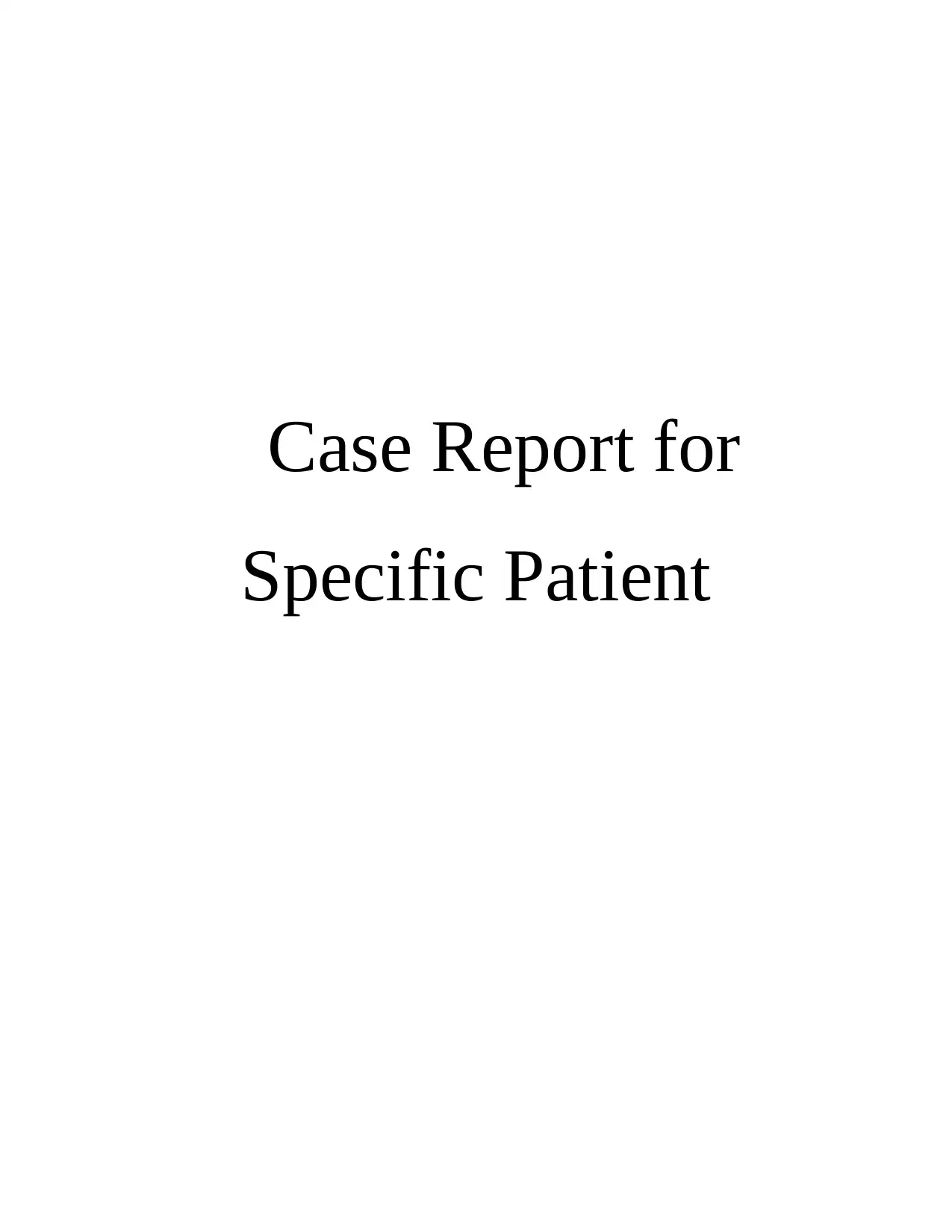
Case Report for
Specific Patient
Specific Patient
Paraphrase This Document
Need a fresh take? Get an instant paraphrase of this document with our AI Paraphraser
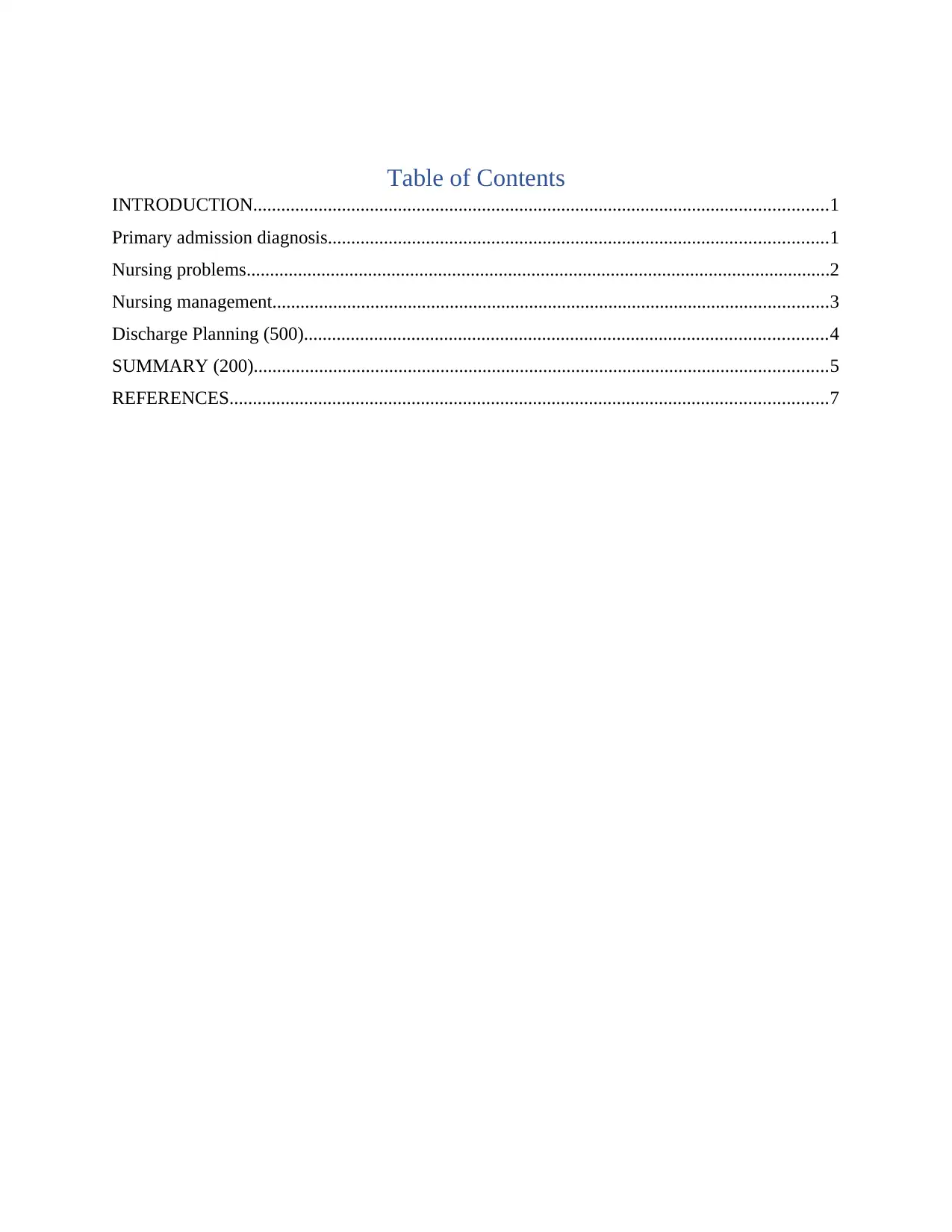
Table of Contents
INTRODUCTION...........................................................................................................................1
Primary admission diagnosis...........................................................................................................1
Nursing problems.............................................................................................................................2
Nursing management.......................................................................................................................3
Discharge Planning (500)................................................................................................................4
SUMMARY (200)...........................................................................................................................5
REFERENCES................................................................................................................................7
INTRODUCTION...........................................................................................................................1
Primary admission diagnosis...........................................................................................................1
Nursing problems.............................................................................................................................2
Nursing management.......................................................................................................................3
Discharge Planning (500)................................................................................................................4
SUMMARY (200)...........................................................................................................................5
REFERENCES................................................................................................................................7
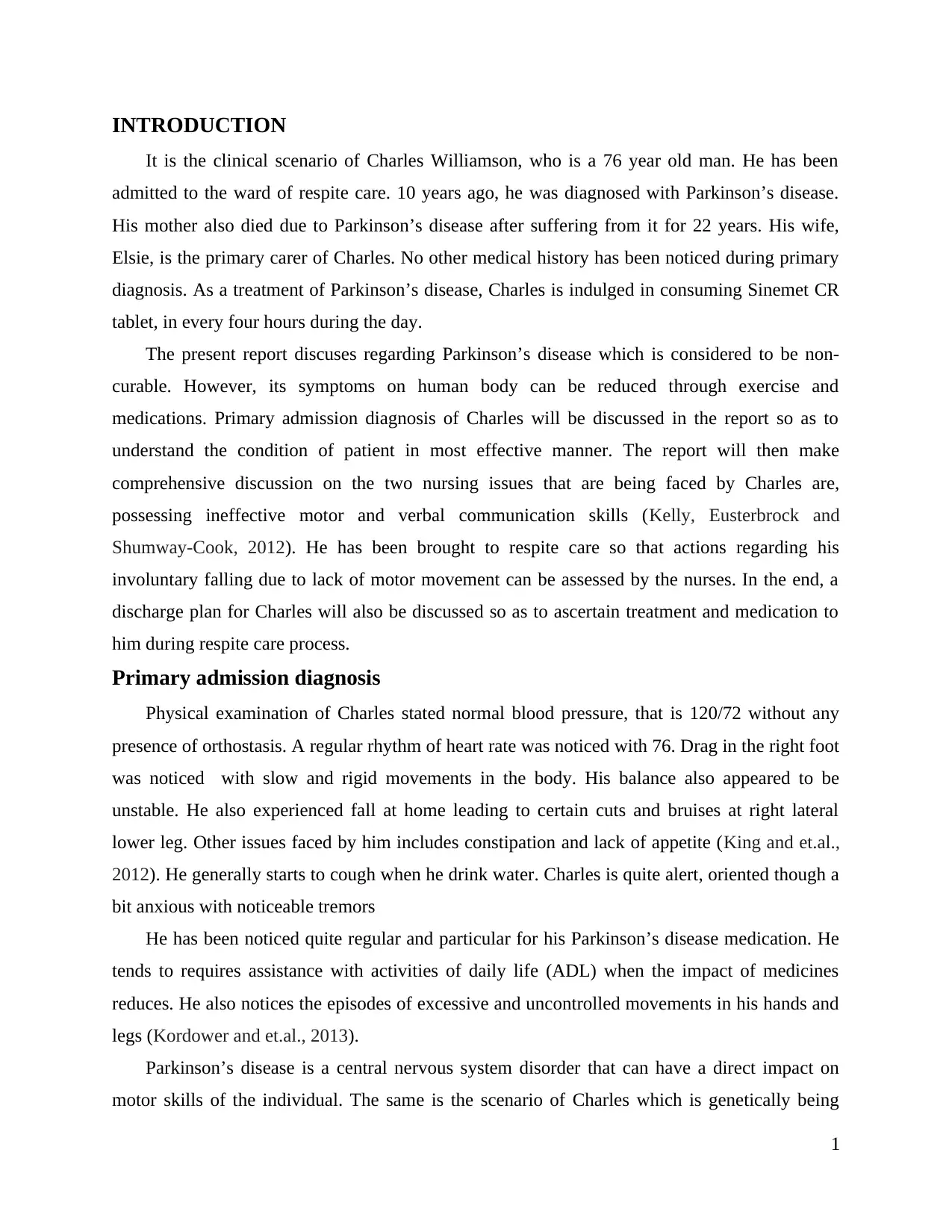
INTRODUCTION
It is the clinical scenario of Charles Williamson, who is a 76 year old man. He has been
admitted to the ward of respite care. 10 years ago, he was diagnosed with Parkinson’s disease.
His mother also died due to Parkinson’s disease after suffering from it for 22 years. His wife,
Elsie, is the primary carer of Charles. No other medical history has been noticed during primary
diagnosis. As a treatment of Parkinson’s disease, Charles is indulged in consuming Sinemet CR
tablet, in every four hours during the day.
The present report discuses regarding Parkinson’s disease which is considered to be non-
curable. However, its symptoms on human body can be reduced through exercise and
medications. Primary admission diagnosis of Charles will be discussed in the report so as to
understand the condition of patient in most effective manner. The report will then make
comprehensive discussion on the two nursing issues that are being faced by Charles are,
possessing ineffective motor and verbal communication skills (Kelly, Eusterbrock and
Shumway-Cook, 2012). He has been brought to respite care so that actions regarding his
involuntary falling due to lack of motor movement can be assessed by the nurses. In the end, a
discharge plan for Charles will also be discussed so as to ascertain treatment and medication to
him during respite care process.
Primary admission diagnosis
Physical examination of Charles stated normal blood pressure, that is 120/72 without any
presence of orthostasis. A regular rhythm of heart rate was noticed with 76. Drag in the right foot
was noticed with slow and rigid movements in the body. His balance also appeared to be
unstable. He also experienced fall at home leading to certain cuts and bruises at right lateral
lower leg. Other issues faced by him includes constipation and lack of appetite (King and et.al.,
2012). He generally starts to cough when he drink water. Charles is quite alert, oriented though a
bit anxious with noticeable tremors
He has been noticed quite regular and particular for his Parkinson’s disease medication. He
tends to requires assistance with activities of daily life (ADL) when the impact of medicines
reduces. He also notices the episodes of excessive and uncontrolled movements in his hands and
legs (Kordower and et.al., 2013).
Parkinson’s disease is a central nervous system disorder that can have a direct impact on
motor skills of the individual. The same is the scenario of Charles which is genetically being
1
It is the clinical scenario of Charles Williamson, who is a 76 year old man. He has been
admitted to the ward of respite care. 10 years ago, he was diagnosed with Parkinson’s disease.
His mother also died due to Parkinson’s disease after suffering from it for 22 years. His wife,
Elsie, is the primary carer of Charles. No other medical history has been noticed during primary
diagnosis. As a treatment of Parkinson’s disease, Charles is indulged in consuming Sinemet CR
tablet, in every four hours during the day.
The present report discuses regarding Parkinson’s disease which is considered to be non-
curable. However, its symptoms on human body can be reduced through exercise and
medications. Primary admission diagnosis of Charles will be discussed in the report so as to
understand the condition of patient in most effective manner. The report will then make
comprehensive discussion on the two nursing issues that are being faced by Charles are,
possessing ineffective motor and verbal communication skills (Kelly, Eusterbrock and
Shumway-Cook, 2012). He has been brought to respite care so that actions regarding his
involuntary falling due to lack of motor movement can be assessed by the nurses. In the end, a
discharge plan for Charles will also be discussed so as to ascertain treatment and medication to
him during respite care process.
Primary admission diagnosis
Physical examination of Charles stated normal blood pressure, that is 120/72 without any
presence of orthostasis. A regular rhythm of heart rate was noticed with 76. Drag in the right foot
was noticed with slow and rigid movements in the body. His balance also appeared to be
unstable. He also experienced fall at home leading to certain cuts and bruises at right lateral
lower leg. Other issues faced by him includes constipation and lack of appetite (King and et.al.,
2012). He generally starts to cough when he drink water. Charles is quite alert, oriented though a
bit anxious with noticeable tremors
He has been noticed quite regular and particular for his Parkinson’s disease medication. He
tends to requires assistance with activities of daily life (ADL) when the impact of medicines
reduces. He also notices the episodes of excessive and uncontrolled movements in his hands and
legs (Kordower and et.al., 2013).
Parkinson’s disease is a central nervous system disorder that can have a direct impact on
motor skills of the individual. The same is the scenario of Charles which is genetically being
1
⊘ This is a preview!⊘
Do you want full access?
Subscribe today to unlock all pages.

Trusted by 1+ million students worldwide
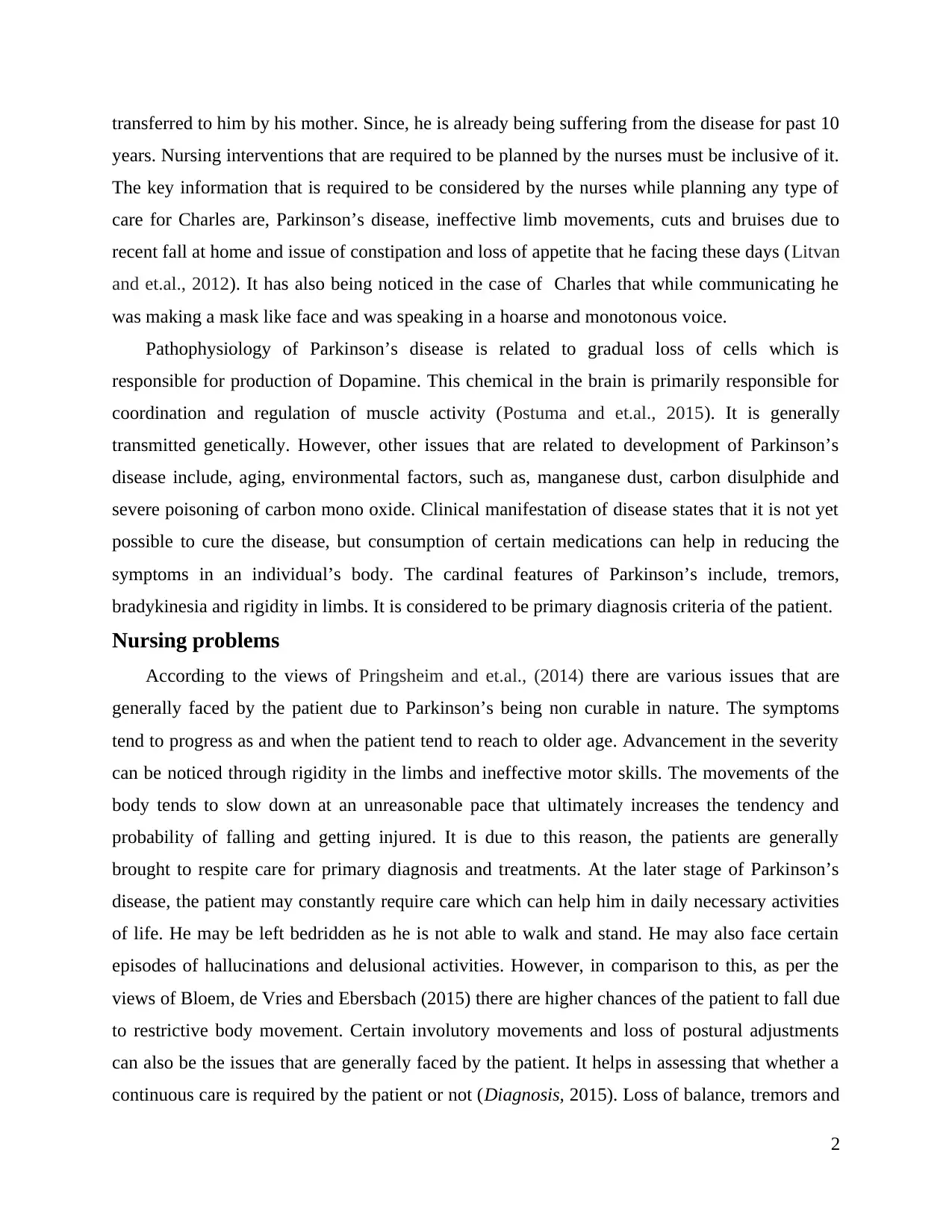
transferred to him by his mother. Since, he is already being suffering from the disease for past 10
years. Nursing interventions that are required to be planned by the nurses must be inclusive of it.
The key information that is required to be considered by the nurses while planning any type of
care for Charles are, Parkinson’s disease, ineffective limb movements, cuts and bruises due to
recent fall at home and issue of constipation and loss of appetite that he facing these days (Litvan
and et.al., 2012). It has also being noticed in the case of Charles that while communicating he
was making a mask like face and was speaking in a hoarse and monotonous voice.
Pathophysiology of Parkinson’s disease is related to gradual loss of cells which is
responsible for production of Dopamine. This chemical in the brain is primarily responsible for
coordination and regulation of muscle activity (Postuma and et.al., 2015). It is generally
transmitted genetically. However, other issues that are related to development of Parkinson’s
disease include, aging, environmental factors, such as, manganese dust, carbon disulphide and
severe poisoning of carbon mono oxide. Clinical manifestation of disease states that it is not yet
possible to cure the disease, but consumption of certain medications can help in reducing the
symptoms in an individual’s body. The cardinal features of Parkinson’s include, tremors,
bradykinesia and rigidity in limbs. It is considered to be primary diagnosis criteria of the patient.
Nursing problems
According to the views of Pringsheim and et.al., (2014) there are various issues that are
generally faced by the patient due to Parkinson’s being non curable in nature. The symptoms
tend to progress as and when the patient tend to reach to older age. Advancement in the severity
can be noticed through rigidity in the limbs and ineffective motor skills. The movements of the
body tends to slow down at an unreasonable pace that ultimately increases the tendency and
probability of falling and getting injured. It is due to this reason, the patients are generally
brought to respite care for primary diagnosis and treatments. At the later stage of Parkinson’s
disease, the patient may constantly require care which can help him in daily necessary activities
of life. He may be left bedridden as he is not able to walk and stand. He may also face certain
episodes of hallucinations and delusional activities. However, in comparison to this, as per the
views of Bloem, de Vries and Ebersbach (2015) there are higher chances of the patient to fall due
to restrictive body movement. Certain involutory movements and loss of postural adjustments
can also be the issues that are generally faced by the patient. It helps in assessing that whether a
continuous care is required by the patient or not (Diagnosis, 2015). Loss of balance, tremors and
2
years. Nursing interventions that are required to be planned by the nurses must be inclusive of it.
The key information that is required to be considered by the nurses while planning any type of
care for Charles are, Parkinson’s disease, ineffective limb movements, cuts and bruises due to
recent fall at home and issue of constipation and loss of appetite that he facing these days (Litvan
and et.al., 2012). It has also being noticed in the case of Charles that while communicating he
was making a mask like face and was speaking in a hoarse and monotonous voice.
Pathophysiology of Parkinson’s disease is related to gradual loss of cells which is
responsible for production of Dopamine. This chemical in the brain is primarily responsible for
coordination and regulation of muscle activity (Postuma and et.al., 2015). It is generally
transmitted genetically. However, other issues that are related to development of Parkinson’s
disease include, aging, environmental factors, such as, manganese dust, carbon disulphide and
severe poisoning of carbon mono oxide. Clinical manifestation of disease states that it is not yet
possible to cure the disease, but consumption of certain medications can help in reducing the
symptoms in an individual’s body. The cardinal features of Parkinson’s include, tremors,
bradykinesia and rigidity in limbs. It is considered to be primary diagnosis criteria of the patient.
Nursing problems
According to the views of Pringsheim and et.al., (2014) there are various issues that are
generally faced by the patient due to Parkinson’s being non curable in nature. The symptoms
tend to progress as and when the patient tend to reach to older age. Advancement in the severity
can be noticed through rigidity in the limbs and ineffective motor skills. The movements of the
body tends to slow down at an unreasonable pace that ultimately increases the tendency and
probability of falling and getting injured. It is due to this reason, the patients are generally
brought to respite care for primary diagnosis and treatments. At the later stage of Parkinson’s
disease, the patient may constantly require care which can help him in daily necessary activities
of life. He may be left bedridden as he is not able to walk and stand. He may also face certain
episodes of hallucinations and delusional activities. However, in comparison to this, as per the
views of Bloem, de Vries and Ebersbach (2015) there are higher chances of the patient to fall due
to restrictive body movement. Certain involutory movements and loss of postural adjustments
can also be the issues that are generally faced by the patient. It helps in assessing that whether a
continuous care is required by the patient or not (Diagnosis, 2015). Loss of balance, tremors and
2
Paraphrase This Document
Need a fresh take? Get an instant paraphrase of this document with our AI Paraphraser
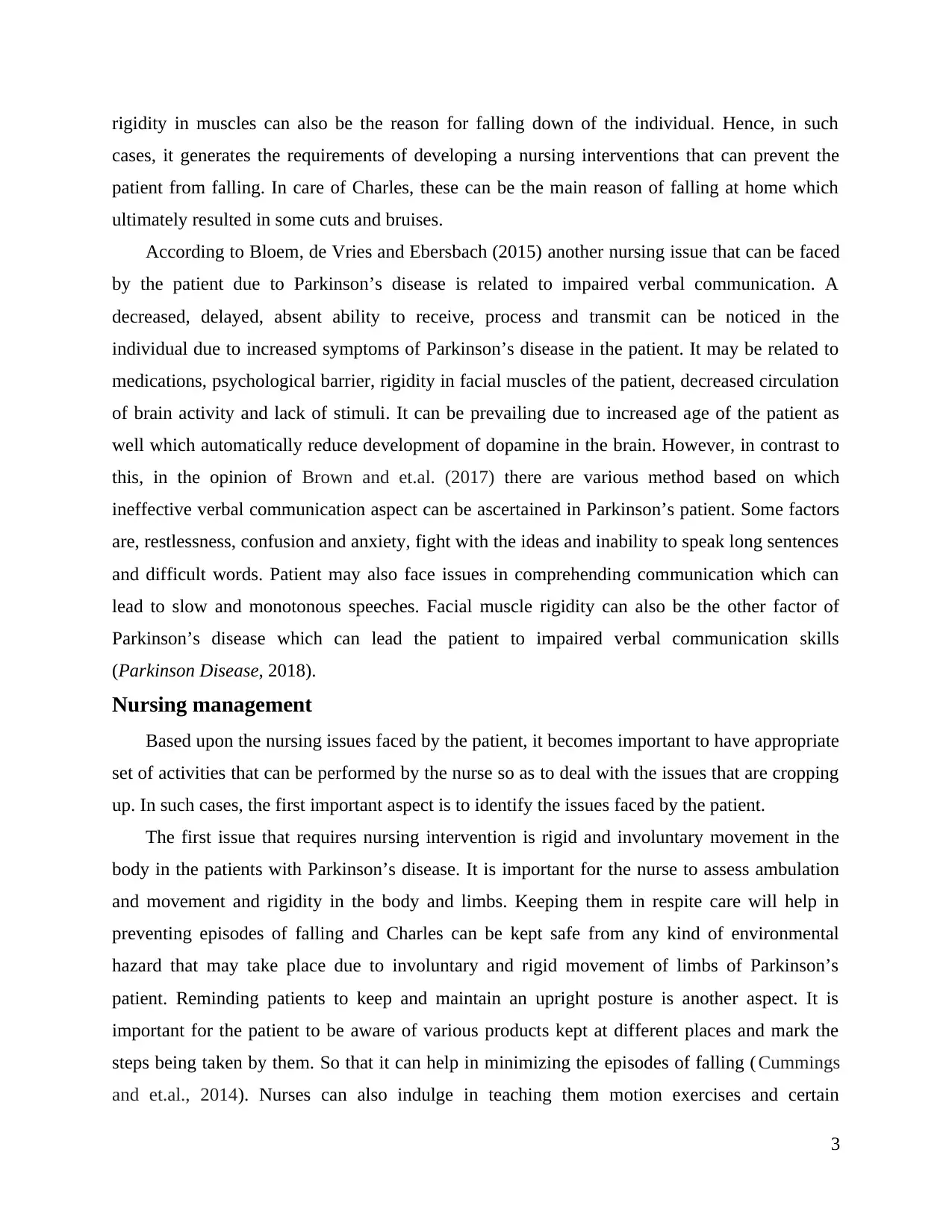
rigidity in muscles can also be the reason for falling down of the individual. Hence, in such
cases, it generates the requirements of developing a nursing interventions that can prevent the
patient from falling. In care of Charles, these can be the main reason of falling at home which
ultimately resulted in some cuts and bruises.
According to Bloem, de Vries and Ebersbach (2015) another nursing issue that can be faced
by the patient due to Parkinson’s disease is related to impaired verbal communication. A
decreased, delayed, absent ability to receive, process and transmit can be noticed in the
individual due to increased symptoms of Parkinson’s disease in the patient. It may be related to
medications, psychological barrier, rigidity in facial muscles of the patient, decreased circulation
of brain activity and lack of stimuli. It can be prevailing due to increased age of the patient as
well which automatically reduce development of dopamine in the brain. However, in contrast to
this, in the opinion of Brown and et.al. (2017) there are various method based on which
ineffective verbal communication aspect can be ascertained in Parkinson’s patient. Some factors
are, restlessness, confusion and anxiety, fight with the ideas and inability to speak long sentences
and difficult words. Patient may also face issues in comprehending communication which can
lead to slow and monotonous speeches. Facial muscle rigidity can also be the other factor of
Parkinson’s disease which can lead the patient to impaired verbal communication skills
(Parkinson Disease, 2018).
Nursing management
Based upon the nursing issues faced by the patient, it becomes important to have appropriate
set of activities that can be performed by the nurse so as to deal with the issues that are cropping
up. In such cases, the first important aspect is to identify the issues faced by the patient.
The first issue that requires nursing intervention is rigid and involuntary movement in the
body in the patients with Parkinson’s disease. It is important for the nurse to assess ambulation
and movement and rigidity in the body and limbs. Keeping them in respite care will help in
preventing episodes of falling and Charles can be kept safe from any kind of environmental
hazard that may take place due to involuntary and rigid movement of limbs of Parkinson’s
patient. Reminding patients to keep and maintain an upright posture is another aspect. It is
important for the patient to be aware of various products kept at different places and mark the
steps being taken by them. So that it can help in minimizing the episodes of falling ( Cummings
and et.al., 2014). Nurses can also indulge in teaching them motion exercises and certain
3
cases, it generates the requirements of developing a nursing interventions that can prevent the
patient from falling. In care of Charles, these can be the main reason of falling at home which
ultimately resulted in some cuts and bruises.
According to Bloem, de Vries and Ebersbach (2015) another nursing issue that can be faced
by the patient due to Parkinson’s disease is related to impaired verbal communication. A
decreased, delayed, absent ability to receive, process and transmit can be noticed in the
individual due to increased symptoms of Parkinson’s disease in the patient. It may be related to
medications, psychological barrier, rigidity in facial muscles of the patient, decreased circulation
of brain activity and lack of stimuli. It can be prevailing due to increased age of the patient as
well which automatically reduce development of dopamine in the brain. However, in contrast to
this, in the opinion of Brown and et.al. (2017) there are various method based on which
ineffective verbal communication aspect can be ascertained in Parkinson’s patient. Some factors
are, restlessness, confusion and anxiety, fight with the ideas and inability to speak long sentences
and difficult words. Patient may also face issues in comprehending communication which can
lead to slow and monotonous speeches. Facial muscle rigidity can also be the other factor of
Parkinson’s disease which can lead the patient to impaired verbal communication skills
(Parkinson Disease, 2018).
Nursing management
Based upon the nursing issues faced by the patient, it becomes important to have appropriate
set of activities that can be performed by the nurse so as to deal with the issues that are cropping
up. In such cases, the first important aspect is to identify the issues faced by the patient.
The first issue that requires nursing intervention is rigid and involuntary movement in the
body in the patients with Parkinson’s disease. It is important for the nurse to assess ambulation
and movement and rigidity in the body and limbs. Keeping them in respite care will help in
preventing episodes of falling and Charles can be kept safe from any kind of environmental
hazard that may take place due to involuntary and rigid movement of limbs of Parkinson’s
patient. Reminding patients to keep and maintain an upright posture is another aspect. It is
important for the patient to be aware of various products kept at different places and mark the
steps being taken by them. So that it can help in minimizing the episodes of falling ( Cummings
and et.al., 2014). Nurses can also indulge in teaching them motion exercises and certain
3
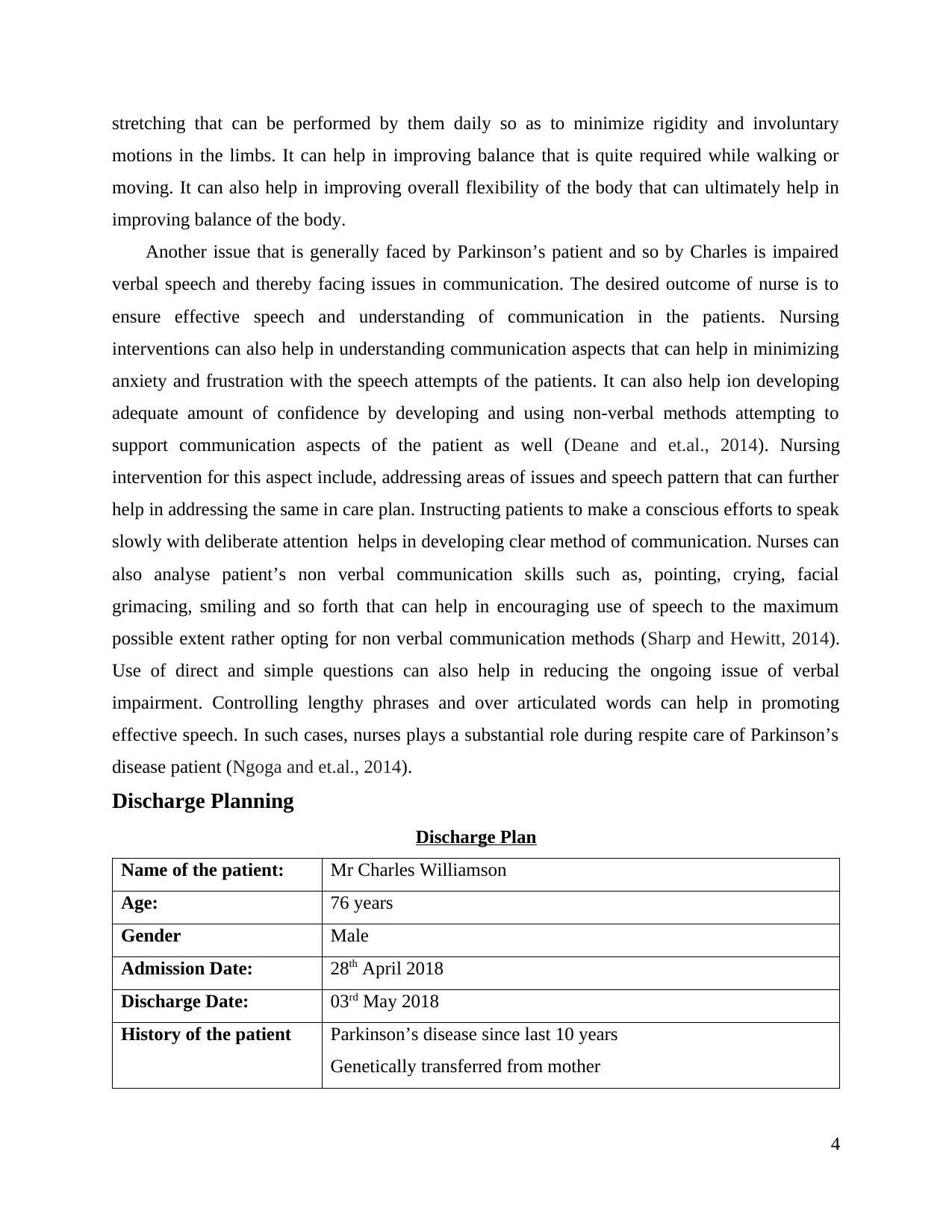
stretching that can be performed by them daily so as to minimize rigidity and involuntary
motions in the limbs. It can help in improving balance that is quite required while walking or
moving. It can also help in improving overall flexibility of the body that can ultimately help in
improving balance of the body.
Another issue that is generally faced by Parkinson’s patient and so by Charles is impaired
verbal speech and thereby facing issues in communication. The desired outcome of nurse is to
ensure effective speech and understanding of communication in the patients. Nursing
interventions can also help in understanding communication aspects that can help in minimizing
anxiety and frustration with the speech attempts of the patients. It can also help ion developing
adequate amount of confidence by developing and using non-verbal methods attempting to
support communication aspects of the patient as well (Deane and et.al., 2014). Nursing
intervention for this aspect include, addressing areas of issues and speech pattern that can further
help in addressing the same in care plan. Instructing patients to make a conscious efforts to speak
slowly with deliberate attention helps in developing clear method of communication. Nurses can
also analyse patient’s non verbal communication skills such as, pointing, crying, facial
grimacing, smiling and so forth that can help in encouraging use of speech to the maximum
possible extent rather opting for non verbal communication methods (Sharp and Hewitt, 2014).
Use of direct and simple questions can also help in reducing the ongoing issue of verbal
impairment. Controlling lengthy phrases and over articulated words can help in promoting
effective speech. In such cases, nurses plays a substantial role during respite care of Parkinson’s
disease patient (Ngoga and et.al., 2014).
Discharge Planning
Discharge Plan
Name of the patient: Mr Charles Williamson
Age: 76 years
Gender Male
Admission Date: 28th April 2018
Discharge Date: 03rd May 2018
History of the patient Parkinson’s disease since last 10 years
Genetically transferred from mother
4
motions in the limbs. It can help in improving balance that is quite required while walking or
moving. It can also help in improving overall flexibility of the body that can ultimately help in
improving balance of the body.
Another issue that is generally faced by Parkinson’s patient and so by Charles is impaired
verbal speech and thereby facing issues in communication. The desired outcome of nurse is to
ensure effective speech and understanding of communication in the patients. Nursing
interventions can also help in understanding communication aspects that can help in minimizing
anxiety and frustration with the speech attempts of the patients. It can also help ion developing
adequate amount of confidence by developing and using non-verbal methods attempting to
support communication aspects of the patient as well (Deane and et.al., 2014). Nursing
intervention for this aspect include, addressing areas of issues and speech pattern that can further
help in addressing the same in care plan. Instructing patients to make a conscious efforts to speak
slowly with deliberate attention helps in developing clear method of communication. Nurses can
also analyse patient’s non verbal communication skills such as, pointing, crying, facial
grimacing, smiling and so forth that can help in encouraging use of speech to the maximum
possible extent rather opting for non verbal communication methods (Sharp and Hewitt, 2014).
Use of direct and simple questions can also help in reducing the ongoing issue of verbal
impairment. Controlling lengthy phrases and over articulated words can help in promoting
effective speech. In such cases, nurses plays a substantial role during respite care of Parkinson’s
disease patient (Ngoga and et.al., 2014).
Discharge Planning
Discharge Plan
Name of the patient: Mr Charles Williamson
Age: 76 years
Gender Male
Admission Date: 28th April 2018
Discharge Date: 03rd May 2018
History of the patient Parkinson’s disease since last 10 years
Genetically transferred from mother
4
⊘ This is a preview!⊘
Do you want full access?
Subscribe today to unlock all pages.

Trusted by 1+ million students worldwide
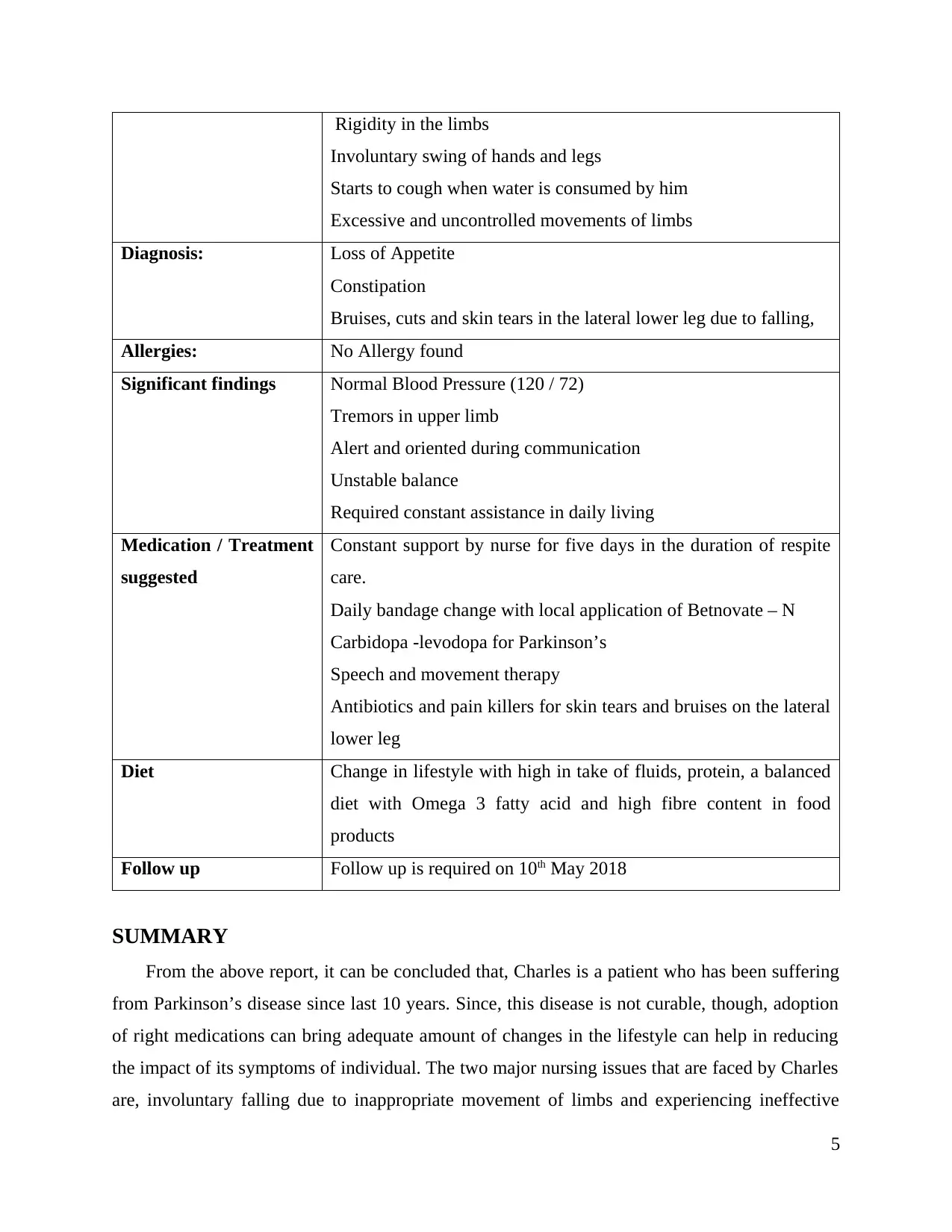
Rigidity in the limbs
Involuntary swing of hands and legs
Starts to cough when water is consumed by him
Excessive and uncontrolled movements of limbs
Diagnosis: Loss of Appetite
Constipation
Bruises, cuts and skin tears in the lateral lower leg due to falling,
Allergies: No Allergy found
Significant findings Normal Blood Pressure (120 / 72)
Tremors in upper limb
Alert and oriented during communication
Unstable balance
Required constant assistance in daily living
Medication / Treatment
suggested
Constant support by nurse for five days in the duration of respite
care.
Daily bandage change with local application of Betnovate – N
Carbidopa -levodopa for Parkinson’s
Speech and movement therapy
Antibiotics and pain killers for skin tears and bruises on the lateral
lower leg
Diet Change in lifestyle with high in take of fluids, protein, a balanced
diet with Omega 3 fatty acid and high fibre content in food
products
Follow up Follow up is required on 10th May 2018
SUMMARY
From the above report, it can be concluded that, Charles is a patient who has been suffering
from Parkinson’s disease since last 10 years. Since, this disease is not curable, though, adoption
of right medications can bring adequate amount of changes in the lifestyle can help in reducing
the impact of its symptoms of individual. The two major nursing issues that are faced by Charles
are, involuntary falling due to inappropriate movement of limbs and experiencing ineffective
5
Involuntary swing of hands and legs
Starts to cough when water is consumed by him
Excessive and uncontrolled movements of limbs
Diagnosis: Loss of Appetite
Constipation
Bruises, cuts and skin tears in the lateral lower leg due to falling,
Allergies: No Allergy found
Significant findings Normal Blood Pressure (120 / 72)
Tremors in upper limb
Alert and oriented during communication
Unstable balance
Required constant assistance in daily living
Medication / Treatment
suggested
Constant support by nurse for five days in the duration of respite
care.
Daily bandage change with local application of Betnovate – N
Carbidopa -levodopa for Parkinson’s
Speech and movement therapy
Antibiotics and pain killers for skin tears and bruises on the lateral
lower leg
Diet Change in lifestyle with high in take of fluids, protein, a balanced
diet with Omega 3 fatty acid and high fibre content in food
products
Follow up Follow up is required on 10th May 2018
SUMMARY
From the above report, it can be concluded that, Charles is a patient who has been suffering
from Parkinson’s disease since last 10 years. Since, this disease is not curable, though, adoption
of right medications can bring adequate amount of changes in the lifestyle can help in reducing
the impact of its symptoms of individual. The two major nursing issues that are faced by Charles
are, involuntary falling due to inappropriate movement of limbs and experiencing ineffective
5
Paraphrase This Document
Need a fresh take? Get an instant paraphrase of this document with our AI Paraphraser
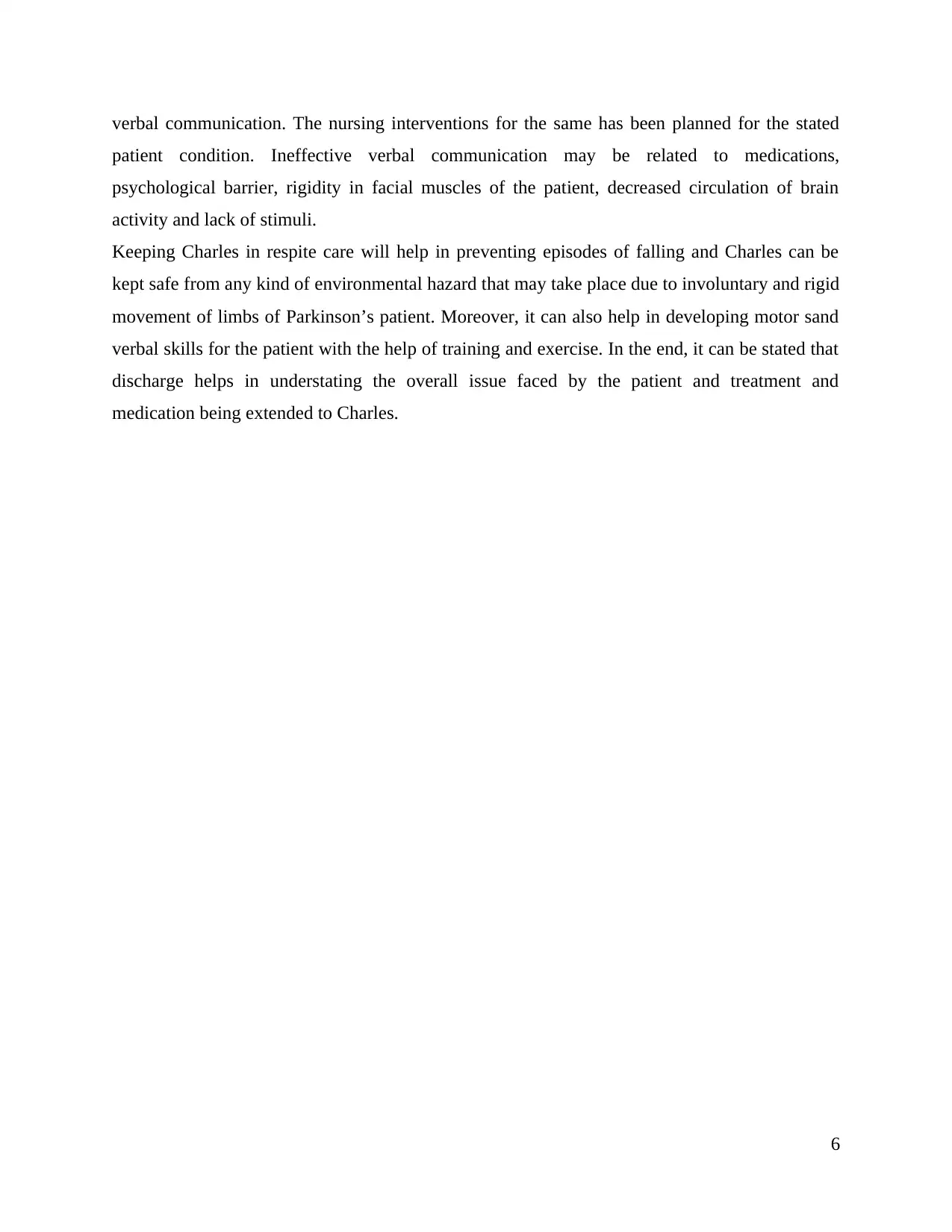
verbal communication. The nursing interventions for the same has been planned for the stated
patient condition. Ineffective verbal communication may be related to medications,
psychological barrier, rigidity in facial muscles of the patient, decreased circulation of brain
activity and lack of stimuli.
Keeping Charles in respite care will help in preventing episodes of falling and Charles can be
kept safe from any kind of environmental hazard that may take place due to involuntary and rigid
movement of limbs of Parkinson’s patient. Moreover, it can also help in developing motor sand
verbal skills for the patient with the help of training and exercise. In the end, it can be stated that
discharge helps in understating the overall issue faced by the patient and treatment and
medication being extended to Charles.
6
patient condition. Ineffective verbal communication may be related to medications,
psychological barrier, rigidity in facial muscles of the patient, decreased circulation of brain
activity and lack of stimuli.
Keeping Charles in respite care will help in preventing episodes of falling and Charles can be
kept safe from any kind of environmental hazard that may take place due to involuntary and rigid
movement of limbs of Parkinson’s patient. Moreover, it can also help in developing motor sand
verbal skills for the patient with the help of training and exercise. In the end, it can be stated that
discharge helps in understating the overall issue faced by the patient and treatment and
medication being extended to Charles.
6
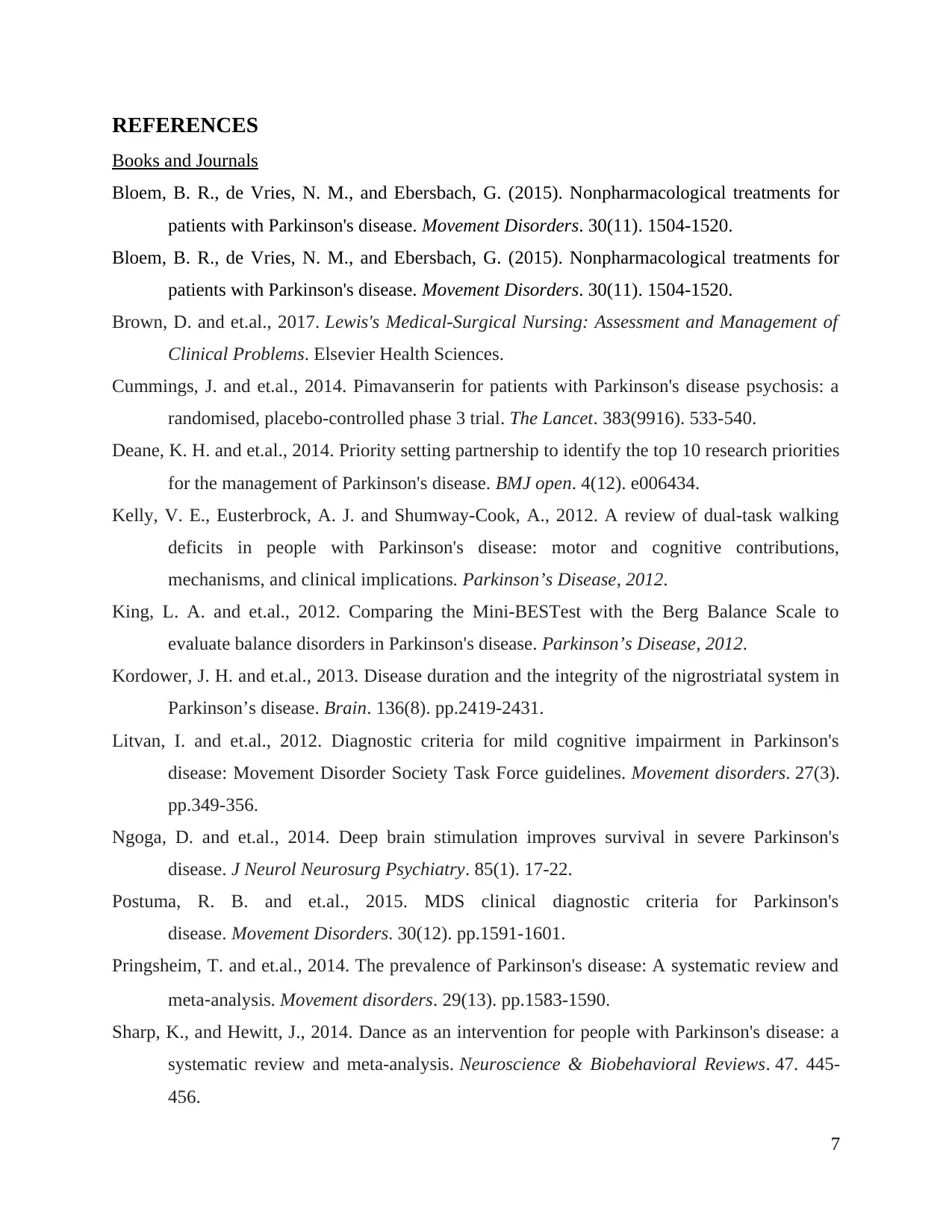
REFERENCES
Books and Journals
Bloem, B. R., de Vries, N. M., and Ebersbach, G. (2015). Nonpharmacological treatments for
patients with Parkinson's disease. Movement Disorders. 30(11). 1504-1520.
Bloem, B. R., de Vries, N. M., and Ebersbach, G. (2015). Nonpharmacological treatments for
patients with Parkinson's disease. Movement Disorders. 30(11). 1504-1520.
Brown, D. and et.al., 2017. Lewis's Medical-Surgical Nursing: Assessment and Management of
Clinical Problems. Elsevier Health Sciences.
Cummings, J. and et.al., 2014. Pimavanserin for patients with Parkinson's disease psychosis: a
randomised, placebo-controlled phase 3 trial. The Lancet. 383(9916). 533-540.
Deane, K. H. and et.al., 2014. Priority setting partnership to identify the top 10 research priorities
for the management of Parkinson's disease. BMJ open. 4(12). e006434.
Kelly, V. E., Eusterbrock, A. J. and Shumway-Cook, A., 2012. A review of dual-task walking
deficits in people with Parkinson's disease: motor and cognitive contributions,
mechanisms, and clinical implications. Parkinson’s Disease, 2012.
King, L. A. and et.al., 2012. Comparing the Mini-BESTest with the Berg Balance Scale to
evaluate balance disorders in Parkinson's disease. Parkinson’s Disease, 2012.
Kordower, J. H. and et.al., 2013. Disease duration and the integrity of the nigrostriatal system in
Parkinson’s disease. Brain. 136(8). pp.2419-2431.
Litvan, I. and et.al., 2012. Diagnostic criteria for mild cognitive impairment in Parkinson's
disease: Movement Disorder Society Task Force guidelines. Movement disorders. 27(3).
pp.349-356.
Ngoga, D. and et.al., 2014. Deep brain stimulation improves survival in severe Parkinson's
disease. J Neurol Neurosurg Psychiatry. 85(1). 17-22.
Postuma, R. B. and et.al., 2015. MDS clinical diagnostic criteria for Parkinson's
disease. Movement Disorders. 30(12). pp.1591-1601.
Pringsheim, T. and et.al., 2014. The prevalence of Parkinson's disease: A systematic review and
meta‐analysis. Movement disorders. 29(13). pp.1583-1590.
Sharp, K., and Hewitt, J., 2014. Dance as an intervention for people with Parkinson's disease: a
systematic review and meta-analysis. Neuroscience & Biobehavioral Reviews. 47. 445-
456.
7
Books and Journals
Bloem, B. R., de Vries, N. M., and Ebersbach, G. (2015). Nonpharmacological treatments for
patients with Parkinson's disease. Movement Disorders. 30(11). 1504-1520.
Bloem, B. R., de Vries, N. M., and Ebersbach, G. (2015). Nonpharmacological treatments for
patients with Parkinson's disease. Movement Disorders. 30(11). 1504-1520.
Brown, D. and et.al., 2017. Lewis's Medical-Surgical Nursing: Assessment and Management of
Clinical Problems. Elsevier Health Sciences.
Cummings, J. and et.al., 2014. Pimavanserin for patients with Parkinson's disease psychosis: a
randomised, placebo-controlled phase 3 trial. The Lancet. 383(9916). 533-540.
Deane, K. H. and et.al., 2014. Priority setting partnership to identify the top 10 research priorities
for the management of Parkinson's disease. BMJ open. 4(12). e006434.
Kelly, V. E., Eusterbrock, A. J. and Shumway-Cook, A., 2012. A review of dual-task walking
deficits in people with Parkinson's disease: motor and cognitive contributions,
mechanisms, and clinical implications. Parkinson’s Disease, 2012.
King, L. A. and et.al., 2012. Comparing the Mini-BESTest with the Berg Balance Scale to
evaluate balance disorders in Parkinson's disease. Parkinson’s Disease, 2012.
Kordower, J. H. and et.al., 2013. Disease duration and the integrity of the nigrostriatal system in
Parkinson’s disease. Brain. 136(8). pp.2419-2431.
Litvan, I. and et.al., 2012. Diagnostic criteria for mild cognitive impairment in Parkinson's
disease: Movement Disorder Society Task Force guidelines. Movement disorders. 27(3).
pp.349-356.
Ngoga, D. and et.al., 2014. Deep brain stimulation improves survival in severe Parkinson's
disease. J Neurol Neurosurg Psychiatry. 85(1). 17-22.
Postuma, R. B. and et.al., 2015. MDS clinical diagnostic criteria for Parkinson's
disease. Movement Disorders. 30(12). pp.1591-1601.
Pringsheim, T. and et.al., 2014. The prevalence of Parkinson's disease: A systematic review and
meta‐analysis. Movement disorders. 29(13). pp.1583-1590.
Sharp, K., and Hewitt, J., 2014. Dance as an intervention for people with Parkinson's disease: a
systematic review and meta-analysis. Neuroscience & Biobehavioral Reviews. 47. 445-
456.
7
⊘ This is a preview!⊘
Do you want full access?
Subscribe today to unlock all pages.

Trusted by 1+ million students worldwide

Online
Parkinson Disease. 2018. [Online]. Available through <https://www.drugs.com/cg/parkinson-
disease-discharge-care.html>
Diagnosis. 2015. [Online]. Available through < https://www.mayoclinic.org/diseases-
conditions/parkinsons-disease/diagnosis-treatment/drc-20376062>
8
Parkinson Disease. 2018. [Online]. Available through <https://www.drugs.com/cg/parkinson-
disease-discharge-care.html>
Diagnosis. 2015. [Online]. Available through < https://www.mayoclinic.org/diseases-
conditions/parkinsons-disease/diagnosis-treatment/drc-20376062>
8
1 out of 10
Related Documents
Your All-in-One AI-Powered Toolkit for Academic Success.
+13062052269
info@desklib.com
Available 24*7 on WhatsApp / Email
![[object Object]](/_next/static/media/star-bottom.7253800d.svg)
Unlock your academic potential
© 2024 | Zucol Services PVT LTD | All rights reserved.





